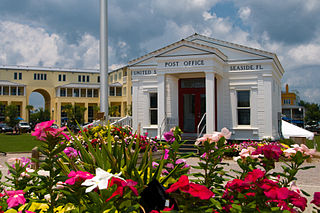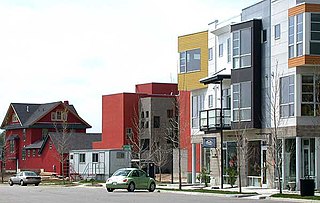Related Research Articles
DPZ CoDesign (DPZ) is an architecture and town planning firm based in Miami, Florida, founded in 1980 by the husband-and-wife team of Andrés Duany and Elizabeth Plater-Zyberk. The firm advocates for New Urbanist town planning in the United States and other countries, having completed designs for over 300 new and existing communities. In addition to Duany and Plater-Zyberk, DPZ's partners include Galina Tachieva, Marina Khoury, Senen M. A. Antonio and Matthew J. Lambert.

New Urbanism is an urban design movement that promotes environmentally friendly habits by creating walkable neighbourhoods containing a wide range of housing and job types. It arose in the United States in the early 1980s, and has gradually influenced many aspects of real estate development, urban planning, and municipal land-use strategies. New Urbanism attempts to address the ills associated with urban sprawl and post-Second World War suburban development.

In economics, induced demand – related to latent demand and generated demand – is the phenomenon whereby an increase in supply results in a decline in price and an increase in consumption. In other words, as a good or service becomes more readily available and mass produced, its price goes down and consumers are more likely to buy it, meaning that the quantity demanded subsequently increases. This is consistent with the economic model of supply and demand.

Seaside is an unincorporated master-planned community on the Florida Panhandle in Walton County, between Panama City Beach and Destin. One of the first communities in America designed on the principles of New Urbanism, the town has become the topic of slide lectures in architectural schools and in housing-industry magazines, and is visited by design professionals from all over the United States.

Andrés Duany is an American architect, an urban planner, and a founder of the Congress for the New Urbanism.

Elizabeth Plater-Zyberk is a professor at the University of Miami's School of Architecture and an architect and urban planner in Miami, Florida.

Kentlands is a neighborhood of the U.S. city of Gaithersburg, Maryland.

Prospect New Town is a New Urbanist housing development located on the southern edge of the city of Longmont in Boulder County, Colorado, in the United States. The first full-scale new urbanist new development in Colorado, it was developed starting in the mid-1990s by Kiki Wallace and designed by the firm of Duany Plater Zyberk & Company, who also designed the new urbanist communities of Seaside, Florida, and Kentlands in Gaithersburg, Maryland. As of 2009, the project is in its sixth phase of development. It is intended to have a population of approximately 2,000 people in 585 units on 340 lots.
Larry Beasley, CM is an internationally known urban planner. Formerly Co-director of Planning for the City Of Vancouver in British Columbia, Canada, he is largely credited with the transformation of its downtown core along New Urbanism lines, known as Vancouverism or "The Vancouver Model".
The urban-to-ruraltransect is an urban planning model created by the New Urbanist Andrés Duany. The transect defines a series of zones that transition from sparse rural farmhouses to the dense urban core. Each zone is fractal in that it contains a similar transition from the edge to the center of the neighborhood. The transect is an important part of the New Urbanism and smart growth movements. Duany's firm DPZ has embodied the transect philosophy into their SmartCode generic planning code for municipal ordinances.
A Form-Based Code (FBC) is a means of regulating land development to achieve a specific urban form. Form-Based Codes foster predictable built results and a high-quality public realm by using physical form as the organizing principle, with less focus on land use, through municipal regulations. An FBC is a regulation, not a mere guideline, adopted into city, town, or county law and offers a powerful alternative to conventional zoning regulation.
SmartCode is a unified land development ordinance template for planning and urban design. Originally developed by Duany Plater-Zyberk & Company, this open source program is a model form-based unified land development ordinance designed to create walkable neighborhoods across the full spectrum of human settlement, from the most rural to the most urban, incorporating a transect of character and intensity within each. It folds zoning, subdivision regulations, urban design, and basic architectural standards into one compact document. Because the SmartCode enables community vision by coding specific outcomes that are desired in particular places, it is meant to be locally calibrated by professional planners, architects, and attorneys.
Landscape urbanism is a theory of urban design arguing that the city is constructed of interconnected and ecologically rich horizontal field conditions, rather than the arrangement of objects and buildings. Landscape Urbanism, like Infrastructural Urbanism and Ecological Urbanism, emphasizes performance over pure aesthetics and utilizes systems-based thinking and design strategies. The phrase 'landscape urbanism' first appeared in the mid 1990s. Since this time, the phrase 'landscape urbanism' has taken on many different uses, but is most often cited as a postmodernist or post-postmodernist response to the "failings" of New Urbanism and the shift away from the comprehensive visions, and demands, for modern architecture and urban planning.
The Mississippi Renewal Forum was a design charrette in which over 200 community leaders and design professionals worked together to plan the rebuilding of the Mississippi Coast post-Hurricane Katrina. In the course of a week in October 2005, the charrette’s design teams generated new plans and codes for all eleven municipalities along the Mississippi coast, including Waveland, Bay St. Louis, Pass Christian, Long Beach, Gulfport, Biloxi, D’Iberville, Ocean Springs, Gautier, Pascagoula and Moss Point.
Louisiana Speaks was a regional plan, published in May 2007, and planning organization for southern Louisiana created in the wake of the destruction caused by Hurricanes Katrina and Rita.

Plan Baton Rouge is a master plan for the redevelopment of the downtown of Baton Rouge, Louisiana. The plan is based on New Urbanist principles.

Mashpee Commons is a lifestyle center located on Cape Cod in the town of Mashpee, Massachusetts. The center opened in 1986 and is considered to be an early example of new urbanist development.
Mitchell J. Silver is an urban planner and former commissioner for the New York City Parks Department.
Moule & Polyzoides, Architects and Urbanists is an architecture and urban planning firm based out of Pasadena, CA founded in 1990 by partners Elizabeth Moule & Stefanos Polyzoides.

Liberty Harbor is a neighborhood in Jersey City, New Jersey situated on the Morris Canal's Big Basin opposite Liberty State Park. The harbor was originally conceived in the 1970s to replace disused land and brownfields.
References
- ↑ "Jeff Speck, Class of 1985". Williams College. September 17, 2016. Retrieved November 26, 2017.
- 1 2 "WEDDINGS/CELEBRATIONS; Alice Ostino, Jeff Speck". The New York Times. April 9, 2006. Retrieved November 26, 2017.
- 1 2 3 4 "Our future depends on walkable communities". The News-Press. October 9, 2015. Retrieved November 28, 2017.
- ↑ Green, Jared (2012). "Interview with Jeff Speck, Hon. ASLA". American Society of Landscape Architects. Retrieved November 28, 2017.
- ↑ Steuteville, Robert (January 1, 2000). "Duany Plater-Zyberk & Company announces coming books". Public Square. Retrieved November 28, 2017.
- ↑ Schmitt, Angie (December 19, 2012). "Author Jeff Speck on Walkability and the One Mistake That Can Wreck a City". Streets Blog. Retrieved November 28, 2017.
- ↑ Ulin, David L. (December 7, 2012). "Jeff Speck's 'Walkable City' a recipe for vibrant street life". Los Angeles Times. Retrieved November 28, 2017.
- ↑ Popova, Maria (November 15, 2012). "The Pedestrian Is a Fragile Species". The Atlantic. Retrieved October 22, 2017.
- ↑ "Jeff Speck, AICP, CNU-A, LEED-AP, Honorary ASLA". Harvard University. Retrieved December 4, 2017.
- 1 2 Thalji, Jamal (March 17, 2005). "Jeff Vinik hires urban planners to start designing $1 billion downtown Tampa project". Tampa Bay Times. Retrieved December 4, 2017.
- 1 2 Hendrickson, Dyke (June 5, 2017). "Waterfront West meeting set for tonight". The Daily News of Newburyport. Retrieved December 4, 2017.
- 1 2 Dawson, Anastasia (June 29, 2015). "Vinik's planner, Jeff Speck, has vision for walkable Tampa". The Tampa Tribune. Retrieved December 4, 2017.
- ↑ Hales, Linda (September 21, 2008). "Meet one of the most unique homes in Washington D.C." The Washington Post. Retrieved December 4, 2017.
- ↑ Gruber, Frank (March 18, 2010). "Half a Bridge: A Review of The Smart Growth Manual by Andres Duany and Jeff Speck with Mike Lydon". HuffPost. Retrieved November 26, 2017.
- ↑ Williams, Monica (December 13, 2012). "How American Cities Can Thrive Again". U.S. News & World Report. Retrieved November 28, 2017.
- ↑ Horan, Richard (November 19, 2012). "Walkable City". The Christian Science Monitor. Retrieved November 28, 2017.
- ↑ Moyer, Justin (February 22, 2013). "'Walkable City: How Downtown Can Save America, One Step at a Time' by Jeff Speck". The Washington Post. Retrieved November 28, 2017.
- 1 2 Hallett, Vicky (September 26, 2014). "House hunting with Jeff Speck, urbanist and author of 'Walkable City'". The Washington Post. Retrieved December 4, 2017.
- ↑ Spendlove, Tom (February 18, 2017). "Designing and Building a More Walkable City". Engineering.com. Retrieved December 4, 2017.
- ↑ "Get to know your CivicCon speakers". Pensacola News Journal. September 22, 2017. Retrieved December 4, 2014.